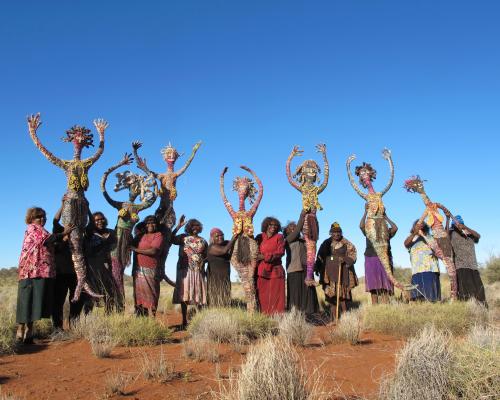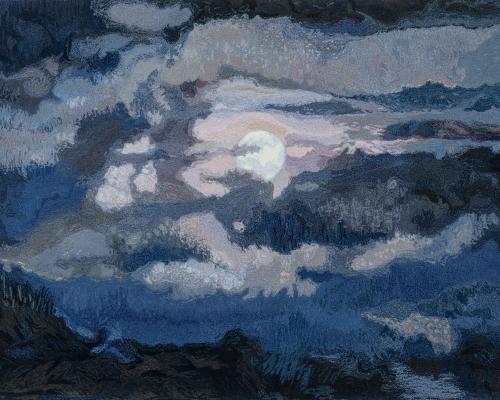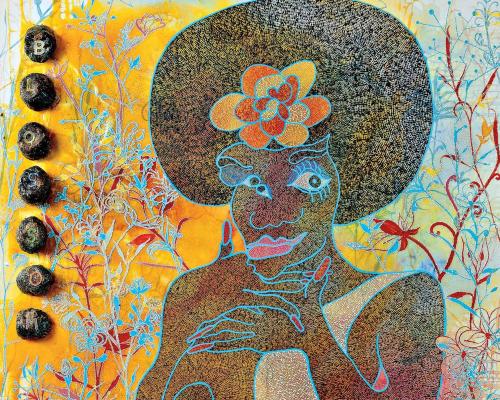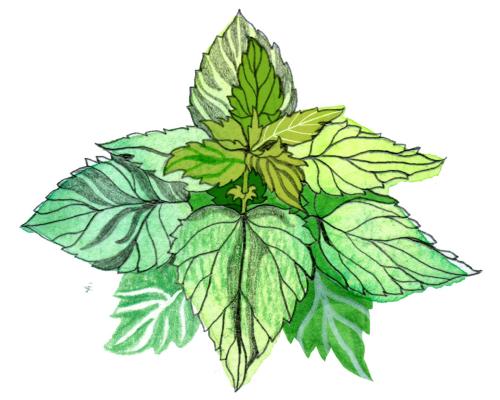
It was about seven years ago, in the remote Northern Territory community of Imanpa, that Pitjantjatjara artist Julie Anderson first tried her hand at the art of tjanpi (wild harvested grass) weaving.
“My aunty taught me how to do it at her place,” she says. “I didn’t like it at first but she said, ‘Give it a go!’ Once I started and learned the steps, I liked it, and now I do it all the time.”
Born circa 1956 at Victory Downs Station, 300km south of Mparntwe/Alice Springs, Anderson once worked as a station hand, cleaner and groundskeeper. It wasn’t until she was in her 60s, living in Mparntwe, that her aunt Margaret Smith taught her how to weave her first tjanpi basket in 2018.
Anderson is now living full-time in a renal hostel in Mparntwe, and is at her happiest when creating: “I have a smile on my face when I’m weaving. I just pick out nice colours and weave them to make nice big baskets.”
Anderson is one of more than 400 women in the Tjanpi Desert Weavers, an Indigenous-run social enterprise that empowers women across 350,000 sq km of central Australia to earn an income through fibre art. When it first started in 1995, the collective’s fibre art focused on more traditional practices, such as making baskets. It has since expanded to 26 remote communities and evolved into more contemporary art and sculptural works, exhibited in Australia and around the world.
Each tjanpi piece holds stories of country, culture and daily life. The often brightly coloured works are woven together with raffia, emu feathers, seeds, gumnuts and twine.
“Each basket or sculpture is more than just an artwork,” the Darwin Aboriginal art fair’s artistic director, Simon Carmichael, says of the Tjanpi Desert Weavers. “It’s a way of keeping culture strong, passing on knowledge, and staying connected to Country. Through weaving, people come together to connect, share, create, and continue something that’s been done for generations.”
The Tjanpi Desert Weavers launched in Papulankutja, Western Australia, as a series of basket-making workshops facilitated by the Ngaanyatjarra, Pitjantjatjara and Yankunytjatjara Women’s Council (NPYWC). It wasn’t long before the women, searching for meaningful and culturally appropriate employment on their homelands, started sharing the artform with their loved ones.
Anderson’s aunt Margaret Smith, who is the NPYWC chair, says the project has multiple benefits: “We are making it with our own hands … Collecting grass for our artwork means collecting bush food, camping out and going out into country.”
It also helps women make money to cover essential expenses such as groceries, powercards and fuel – and it can also “settle the mind down from all the worries”, she says.
Anderson’s niece Justine is also in the Tjanpi Desert Weavers. Based in remote Aputula (Finke) in the Northern Territory, she first started learning in 2010 at a workshop in Amata, an Aboriginal community near the border between South Australia and the Northern Territory.
Justine’s sculptures often depict local animals with fanciful details, such as life-like saddles on the backs of her kamula (camels), or the tongue and whiskers of a panting papa (dog). Vibrant wool and raffia stitching is also a distinctive characteristic of her work.
Weaving keeps her “happy and busy”. “It’s a way for me to keep food on the table and make my kids happy,” she says. “My boys go to school down in Adelaide, so my weaving means they have some spending money too.”
Justine passed her skills on to family members including her sister, who is also a Tjanpi weaver; Cynthia Burke, another Tjanpi weaver, learned by watching her mum and aunty during the group’s early years.
Sitting together as a collective, laughing and joking while weaving, is an important part of the enterprise, she says.
“When you sit down at home on the weekend or go somewhere to other places, sometimes for sorry business, ladies always take their raffia so they can sit down and do their weaving together,” she says. “I feel proud when I sell my work and work for Tjanpi.”
Smith emphasises the benefits of passing on skills and cultural knowledge to younger generations. “All my daughters know how to make tjanpi. They love it. It gives our young people pride,” she says.
While the women of Tjanpi Desert Weavers speak openly about the cultural, financial and emotional benefits of their work, they’ve also made significant strides in the art world over the past 30 years. In 2005, a group of Tjanpi artists won the major prize in the National Aboriginal and Torres Strait Islander Art Awards (Natsiaa) for their giant woven Tjanpi Toyota. In 2015, a collaborative work between the Tjanpi Desert Weavers and artist Fiona Hall was exhibited at the Venice Biennale. Two years later, Tjanpi works were a major feature of the exhibition Songlines: Tracking the Seven Sisters at the National Museum of Australia, which subsequently toured to the UK, France and Germany; it will travel to India later this year, followed by China in 2026.
One of the group’s sculptural installations, Kungkarangkalpa (Seven sisters), is a centrepiece of the exhibition 65,000 Years: A Short History of Australian Art at the Potter Museum of Art in Melbourne. The co-curator Judith Ryan describes the work as a “palpable, fully three-dimensional manifestation” of the creation myth, “spectacular in its scale and presence”. “I believe this is the Tjanpi Desert Weavers’ magnum opus,” she adds.
But not all their works are grand. In August, Justine is exhibiting a new work at Darwin Aboriginal art fair: a lampshade made from brightly woven raffia and tjanpi. She just wants people to enjoy her work: “I hope my artwork makes them feel homey wherever they put it, and reminds them of me,” she says. “It’s good to see my art out there, you know?”







